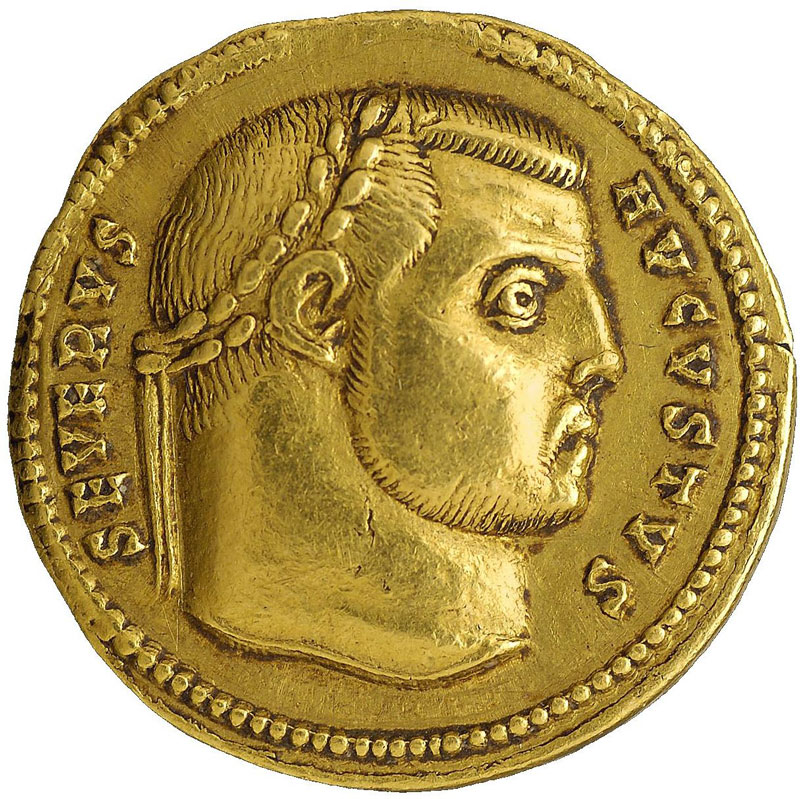Life: AD ? – 307

- Name: Flavius Valerius Severus
- Born in the Danubian region, date unknown.
- Became emperor in August AD 306.
- Wife: (1) unknown (one son; Severus).
- Died at Rome, 16 September AD 307.
Severus II is a shadowy figure of whom little is known.
Of his birth all that is clear is that it was somewhere in the Danubian region. The date and place are unknown, so too his parents.
Like all the other Danubian leaders of that time, Severus II had risen through the ranks of the army until in AD 305 Maximian at his abdication nominated Severus II to be the western Caesar.
It was at that point that he adopted the names Flavius (as the adoptive son of Constantius) and Valerius (as an adopted member to the house of Diocletian).
As western Caesar Severus II was allocated Italy and Africa and Pannonia to administer. Pannonia was actually the domain of the east and hence partial to the control of the eastern Augustus Galerius. But as Galerius had effective control of both Caesars this territorial irregularity didn’t really matter.
The appointment of Severus II (and Maximinus II Daia as co-Caesar) surprised everyone. The two Caesars were largely unknown. Whereas the son of Constantius Chlorus, Constantine, and the son of Maximian, Maxentius, were well known and generally expected to accede to the throne.
Many saw particularly in Severus II’s elevation merely the patronage of Galerius. For Severus II was supposedly an old friend and drinking companion of that emperor.
When in July AD 306 Constantius Chlorus died in Britain, Galerius a few days later, in August AD 306, promoted Severus II to be his junior co-Augustus. Constantius’ son Constantine was made Caesar in his place.
Was the elevation of Constantine made in order to overcome his disappointment at not having been made Caesar at his father’s death, then it left Maximian’s son Maxentius out in the cold.
So Maxentius launched a revolt in Rome. The thoroughly discontent praetorians provided the usurper with all the support he needed, for Severus II had announced his intention to abolish the praetorians altogether.
As news of the revolt reached Galerius he asked his co-emperor to march on Rome and in early AD 307 Severus II set out from his capital at Mediolanum (Milan).
Severus II was well supported in northern Italy but at reaching Rome he ran into trouble. Maxentius had called his father Maximian back from retirement. Had Severus II’s troops no loyalty towards Maxentius, then they still felt strongly for their old emperor Maximian. And Maximians’ agents had little problem causing trouble among the army.
Torn between their loyalty to two emperors, the troops mutinied.
Even Severus II’s praetorian prefect turned against him and started promising bonuses to men who would change their allegiance.
Severus II could do nothing else but withdraw as quickly as possible with the few troops which remained loyal to him. But Maximian now pursued him with his troops. Caught up with at Ravenna, Severus II was forced to agree terms of surrender. He agreed to abdicate if his life were spared.
Severus II was so taken prisoner and paraded through the streets of Rome. Then he was imprisoned to provide a hostage against any attacks by Galerius.
Once Galerius did attack though, Maxentius and Maximian saw him off without much trouble. This in their minds eliminated any reason for further needing a hostage. Severus II now only posed a risk to them. For he might still have escaped.
Hence on 16 September AD 307 Severus II was put to death by order of Maxentius.

Historian Franco Cavazzi dedicated hundreds of hours of his life to creating this website, roman-empire.net as a trove of educational material on this fascinating period of history. His work has been cited in a number of textbooks on the Roman Empire and mentioned on numerous publications such as the New York Times, PBS, The Guardian, and many more.
